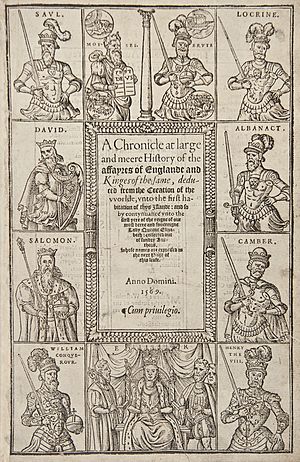Richard Grafton facts for kids
Richard Grafton (born around 1506 or 1511 – died 1573) was an important printer in England. He worked as the official printer for King Henry VIII and King Edward VI. He was a member of the Grocers' Company, a group for merchants. He also served as a Member of Parliament (MP) for Coventry in 1562-63.
Printing Bibles for the King
Richard Grafton became very interested in printing the Bible in English. He worked with Edward Whitchurch, another printer. Together, they published the Matthew Bible in 1537. This Bible was actually printed outside England. In 1538, they brought printing presses and workers from Paris. They used these to print the first edition of the Great Bible in England.
Grafton and Whitchurch often worked together. Grafton set up his printing press in an old monastery building. In 1541, they received a special permission from the King. This allowed them to be the only ones to print new church books. These included the first Book of Common Prayer. They also got permission to print prayer books called primers.
In 1541, Grafton was sent to Fleet Prison. This was because he printed a letter from Philip Melanchthon. He was also accused of printing songs that supported Thomas Cromwell. In April 1543, Grafton and seven other printers were sent to prison again. This was for printing books that were thought to be against the law. For Grafton, it was because he had printed the Great Bible. He stayed in prison for six weeks. He then had to promise not to sell or print any more Bibles. This promise lasted until the King and church leaders agreed on a new translation.
Life Under Edward VI and Later Years
When Edward VI became King, Grafton was named the King's Printer. This gave him the special right to print all new laws and rules. He held this important job for six years. When the King died, Grafton printed a statement. This statement announced that Lady Jane Grey was the new Queen. He signed it as "Printer to the Queen." Because of this, Queen Mary I sent him to prison. John Cawood then became the Queen's Printer. This ended Grafton's career as a printer.
While in prison, Grafton started writing. He put together a book called Abridgement of the Chronicles of England. He published this book in 1563. It included the first printed English version of the verse "Thirty Days Hath September...". Older handwritten versions of this verse have been found. Later, in 1568–9, he added another book called A Chronicle at Large. These books are not always seen as completely accurate. They do not contain much new information. John Stow, another writer, and Grafton had arguments. Stow said Grafton copied his work, which was true. In A Chronicle at Large, Grafton was the first writer known to print the name "Black Prince" for Edward of Woodstock. The reason for this name is still not fully clear. Grafton said he found it in other writers.
Grafton also played a role in setting up and supporting London hospitals. He died in 1573, probably in late April or early May. He was buried on May 14 in Christ Church Greyfriars in London. He had four sons and one daughter, Joan. Joan married another printer named Richard Tottel. Grafton's special symbol was a tree with new branches, called grafts. These grafts came from a barrel, like the ones used to pack books. This symbol was a rebus, a picture puzzle for "graft-tun" (Grafton).
See also


